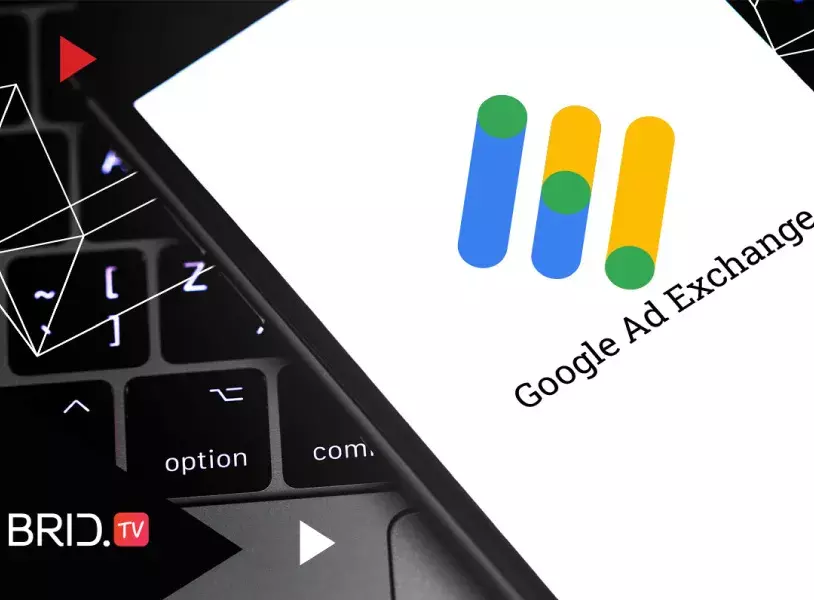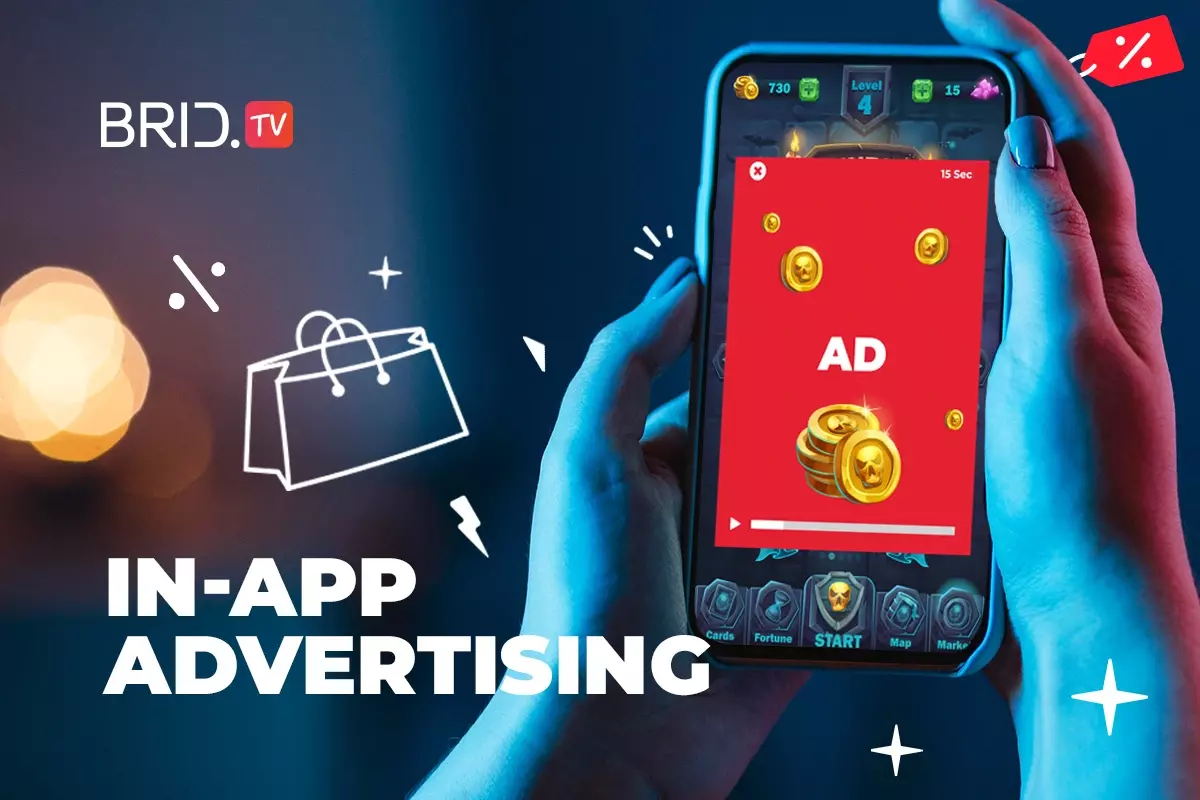Mobile apps are often lauded as the best generator of passive income today, especially in terms of in-app advertising. But how does advertising in mobile apps actually work? How do you monetize your app? And are ads even the best monetization option for your app specifically? To help you get started on your app monetization journey, we’ve put together the ultimate guide to in-app advertising for publishers.
- What Is In-App Advertising?
- How Does In-App Advertising Work?
- Benefits of In-App Advertising
- Drawbacks of In-App Advertising
- In-App Advertising vs. In-App Purchases
- How Much Does In-App Advertising Cost?
- How Much Money Can You Earn From In-App Advertising?
- Most Popular In-App Advertising Formats
- How to Start With Mobile In-App Advertising?
- 5 Best In-App Advertising Platforms for Publishers and Developers
- Get Started With In-App Advertising With Brid.TV Marketplace
- FAQ
What Is In-App Advertising?
In-app advertising is a type of digital advertising that takes place within apps, usually for mobile devices. App developers and publishers sell their ad inventory to buyers, i.e., brands and advertisers to generate revenue. In-app advertising is especially popular in gaming apps, social media apps, and entertainment and streaming apps.
How Does In-App Advertising Work?
On the surface, mobile advertising seems quite simple. A user opens an app, sees an ad, and the publisher receives money from the advertiser for showing said ad. However, behind the scenes, the process is much more complex.
The Mobile Advertising Ecosystem Explained
There are several major players in the mobile advertising ecosystem. On the sell-side, there are publishers/developers and supply-side platforms. On the buy side, there are brands/advertisers and demand-side platforms. Between the two stand mobile ad networks and exchanges, which act as intermediaries.
So what does the process of mobile advertising actually look like? Although they may differ depending on various factors, the general steps are as follows:
- A user opens an app or triggers an in-app ad request otherwise (for instance, by requesting a rewarded video ad for an in-game currency).
- The app sends the request to the publisher’s network or ad exchange. The request contains specific information, such as the type of ad and the floor price.
- The ad network or exchange processes the request against offers sent in by the demand side of the ecosystem.
- Once the network identifies the best match for the request (i.e., an ad that has the highest price and fits all the other criteria), the user sees the advertisement in the app.
Benefits of In-App Advertising
Advertising is one of the most popular app monetization strategies. As such, it certainly has a lot of benefits, both for publishers and advertisers:
- It Attracts a Larger Audience — Not everyone is prepared to spend money to be able to download or use an app. For the majority of mobile users, seeing an occasional ad is a good trade-off for a free product.
- It Boosts User Engagement — Sometimes, ads might even incite your users to stay in the app longer. For instance, if you have published a mobile game where players have limited lives, a user might request a rewarded video ad to receive extra lives and keep playing.
- It Works Well With Other Monetization Models — If you want to combine multiple monetization models into your strategy, chances are that ads will be in that mix. For instance, you can offer a free, ad-supported version of the app, along with a premium, ad-free version for paying customers.
- It Allows for Better Targeting — Unlike websites, which use cookies to track user activities, apps use device IDs. These hold much more valuable data for better ad targeting and, by extension, lead to better performance and higher ad yield.
Drawbacks of In-App Advertising
While in-app advertising has many benefits, it isn’t without drawbacks. Let’s take a look at the major ones:
- It Can Put Some Users Off — Not everybody is willing to tolerate ads in exchange for a free product. In other words, some users might stay away from your app if it is exclusively ad-supported and doesn’t offer an ad-free version.
- It Requires Some Know-How — Although programmatic advertising has made selling ad inventory a much easier task, you will still need to know what you’re doing to ensure you get the most out of your monetization efforts.
- It’s Not Suitable for Every Type of App — Depending on the type of app you want to launch, ads might not be the right monetization strategy for you. This includes, for instance, apps that require quick action, such as local emergency alerts or health alerts.
In-App Advertising vs. In-App Purchases
You might still be in two minds about which monetization approach to take — ads or in-app purchases (IAP). In reality, these two options don’t have to be mutually exclusive. Quite the contrary, advertising and IAP complement each other quite well and can take your monetization efforts to a whole new level.
Studies have shown that certain mobile ad formats, namely rewarded ads, can positively affect user spending and increase the volume of in-app purchases. For instance, your mobile game might grant three extra lives for three rewarded ads viewed and then prompt the user to purchase additional lives beyond that.
How Much Does In-App Advertising Cost?
There are many factors that go into determining the price of an in-app ad. However, we can still talk about averages. The table below shows average eCPMs (effective cost-per-mille) by country for iOS apps in 2022.
| Country | Rewarded Video Ads | Interstitial Ads | Banner Ads |
|---|---|---|---|
| US | $12.5 | $8.9 | $0.22 |
| UK | $9.6 | $5.7 | $0.18 |
| Australia | $11 | $6.5 | $0.22 |
| Japan | $12.3 | $6.7 | $0.12 |
Now, let’s take a look at average eCPMs per country for the same formats on Android.
| Country | Rewarded Video Ads | Interstitial Ads | Banner Ads |
|---|---|---|---|
| US | $13 | $10.2 | $0.49 |
| UK | $6 | $5.2 | $0.27 |
| Australia | $10.6 | $7.8 | $0.37 |
| Japan | $10 | $5.6 | $0.14 |
It is important to note that these amounts depend on factors such as the mobile ad network of your choice, the type of app, the size of the user base, and more. Of course, they also depend on the pricing model you decide to use. And if you still haven’t settled for one, let’s take a look at the most common pricing models and their advantages and disadvantages.
CPM
CPM, also known as cost per mille, is a pricing system that measures the cost of an ad for every 1,000 views it gets. This is the most commonly used pricing model in programmatic advertising.
For publishers, the biggest advantage of the CPM model is that simply showing an ad is enough to generate revenue. However, the CPM of an ad is usually lower than its CPC or CPA would be. In other words, CPM is great for publishers with a large user base who can count on a high number of ad views to offset the lower prices.
CPC
CPC, or cost per click, calculates the price of an ad per each click it gets. In other words, it is not enough for publishers to simply show the ad — the user must also click on it for the publisher to make a profit. On the other hand, publishers can ask for a higher CPC than they would CPM.
CPA
CPA, or cost per action, is a somewhat more complex model than the previous two. With CPA, the user must carry out a certain action, such as a purchase or a sign-up. For publishers, this means higher floor prices, but also a lower volume of ads that meet the payout criteria.
CPI
The CPI model, also known as cost per install, calculates the price of an ad for each user that installs the app being advertised. In other words, users have to view and click on the ad and then install the app. This long chain of actions means that the volume of payout-qualified ads will be much lower than with CPM, but the floor price will be much higher than in most other pricing models.
How Much Money Can You Earn From In-App Advertising?
Last year, the in-app ad spend reached $240 billion worldwide. In other words, advertisers all around the globe are investing in mobile ads. So how much can app publishers expect to make this way?
The truth is that there is no straightforward answer to this question. Your revenue will depend on the number and type of ads in your app, the number of daily active users, your mobile ad network, and more.
Top-earning apps on app stores generate tens of thousands of dollars each day. More realistically, however, with the right setup and know-how, an app with 1000 daily active users can generate anywhere from a dozen to several hundred dollars a day.
Most Popular In-App Advertising Formats
There are many different types of ads you can include in your app. However, not all of them will be equally effective. The right choice of an ad depends on a number of factors, with the most important one being the type of app you have. Let’s take a look at the major mobile ad formats at your disposal.
Banner Ads
Banner ads are a staple of display advertising and one of the most common ad formats out there. They can come in different shapes and sizes, and usually take up the edge of the screen, remaining relatively unintrusive. The banner itself may contain static or dynamic visuals, and it might even follow the user as they scroll.
Video Ads
Video ads are advertisements that show up within a video stream (these are known as instream video ads). For instance, if you have an OTT app similar to YouTube, you can place ads before, during, and/or after a video (these are known as pre-roll, mid-roll, and post-roll ads, respectively).
If you don’t have any video content on your app, you can still make use of mobile video advertising. For instance, you can implement outstream video ads, which show up within various ad units such as banners or interstitials.
Native Ads
Native advertisements blend into the rest of the content and don’t stand out as ads right away. For instance, a news app might include ads that look like news articles but contain promotional content. Because they need to fit the appearance of the rest of the app, native ads don’t necessarily have standardized shapes and sizes.
Interstitial Ads
Interstitial ads take up the whole screen of the device, making it impossible for the user to access the app until the ad is over or they click out of it. They are highly intrusive ads that can negatively affect user experience, but they do have high click-through rates. Still, interstitials are one of the most popular mobile ad formats, and if used sparingly, can have little effect on user experience.
Rewarded Video Ads
Rewarded video ads are especially popular in mobile game monetization strategies. These ads grant the user an in-game reward, such as currency or extra lives, for viewing the advertisement. They can also be found in non-game apps, although not as commonly. The main drawback of rewarded ads is that users are usually more focused on the reward than the ad itself.
Playable Ads
Playable ads are a type of rich media ads. As the name suggests, these ads contain game-like elements, and app users can play them. Usually, the ad redirects to a landing page after a certain amount of time or after the user has taken a certain number of actions in the game. Playable games are highly engaging and among user favorites.
How to Start With Mobile In-App Advertising?
If you’re interested in monetizing your mobile app through ads, you will first need to find a reliable app monetization platform, i.e., an ad network, that can help you. You will also have to make some decisions, such as what types of ads you want to show or whether you will combine this with another monetization model.
The process of actually setting up ads will differ depending on your choice of ad network. However, a good network will ensure this is an easy and straightforward task. Once that has been done, all you need to do is keep track of analytics and adjust any variables to maximize ad revenue.
5 Best In-App Advertising Platforms for Publishers and Developers
With the right mobile advertising platform by your side, you will be able to easily sell ad inventory, achieve higher ad fill rates, and generate more revenue. In other words, your choice of platform can have a major impact on the success of your monetization strategy. To make this decision easier, we’ve put together a short list of the top in-app advertising platforms on the market right now.
1. Brid.TV Marketplace
Brid.TV Marketplace is a programmatic ad platform that focuses on digital video advertising. The platform allows publishers to monetize anything from websites to CTV and OTT apps. Although Brid.TV Marketplace’s solution works best with existing video content, even publishers without a video library can use the platform to monetize through outstream video ads and display advertising.
Brid.TV Marketplace relies on state-of-the-art programmatic video advertising solutions. It provides publishers with premium demand from sources such as Google ADX. Lastly, the solution comes with in-depth reporting and analytics, making ad yield optimization a piece of cake.

2. Google AdMob
Google AdMob is one of the largest and best-known mobile ad networks on the market right now. It allows publishers to monetize mobile apps of all kinds through high-quality ad demand and an array of standardized ad formats.
Although hailed as the king of mobile advertising, Google AdMob is not the best solution for smaller publishers and developers. Apps with lower traffic can’t stand to earn much through the platform, and the minimum payout amount is pretty high, too.
3. InMobi
InMobi is another popular app monetization network tailored to both publishers and advertisers. It features a wide range of ad formats, including rich media and custom native ads. InMobi integrates with hundreds of DSPs to provide high-quality ad demand to publishers everywhere.
4. Unity Ads
Unity Ads is a part of an all-in-one ecosystem designed to help developers with every step of the app development process. The Unity Ads platform features various mobile-friendly solutions, including a proprietary ad exchange. Unity Ads also allows developers to combine the ad-based monetization model with in-app purchases for maximum revenue.
5. Smaato
Smaato is an ad platform with a proprietary ad server. Although the platform is mobile-first, it does provide monetization solutions for other channels, too. Smaato puts a lot of emphasis on OTT advertising, making it a great choice for developers of OTT streaming service apps. Lastly, it comes with high-end fraud prevention, along with in-depth ad analytics.
Get Started With In-App Advertising With Brid.TV Marketplace
Ready to start monetizing your mobile app through advertisements? Then join Brid.TV Marketplace and access an array of ad formats, demand sources, and features designed to make your monetization efforts a success. Our state-of-the-art real-time bidding solution will make selling ad inventory a breeze. And with detailed ad analytics and reports, you’ll have clear insight into how well your app is doing.
On top of a video ad network, Brid.TV is also a comprehensive online video platform. In other words, if you need a solution to help you host, manage, and distribute video content, in addition to monetizing your app, you can count on us.
· Premium Google ADX Demand
· Omnichannel Monetization
· Rich Selection of Video Ad Formats
· Real-Time Performance Tracking
· Automated Reporting

FAQ
1. What is in-app advertising?
In-app advertising is a branch of digital advertising that happens within mobile apps. In-app advertising is one of the main monetization models for mobile applications, along with in-app purchases.
2. How much money can you make from in-app advertising?
You can make anywhere from tens to thousands of dollars a day with in-app advertising. However, your precise revenue will depend on a number of factors, such as the ad network you choose, the pricing model, the type and number of ads, and more.
3. How much does in-app advertising cost?
In-app advertising is usually free for publishers, while advertisers have to pay to buy ad space. Usually, ad networks take a cut from ad revenue instead of charging money.
4. How does in-app advertising work?
In-app advertising works similarly to other digital advertising formats. First, the publisher’s app sends an ad call to the ad network. Then, the network gathers offers and picks the one that fits all requirements and has the highest price.

